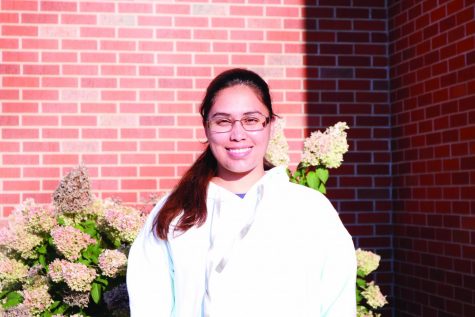Anatomy professor calls it a career
Pedersen taught more than 13,000 students, helped improve SDSU program
October 4, 2022
Scott Pedersen officially retired from his duties May 11, concluding a career spanning 46 semesters of teaching and well over 13,000 students in his anatomy courses.
Pedersen completed his undergraduate and master’s degree in biology at UC-Boulder. He then his doctorate degree at UN-Lincoln.
He said that what led him to be an anatomy instructor was his interest in the integration of musculoskeletal dynamics and the generation of musculoskeletal dynamics during fetal development.
Pedersen started working at South Dakota State University in 1999, focusing on anatomy and evolution courses. Over time, he’s taught Anatomy 221, Anatomy 221 Honors, Anatomy 721, Evolution, Developmental Biology, several sections of 494 Internship, 494 Independent Research and Graduate seminar 790.
In terms of developing and strengthening the anatomy course, he integrated cadavers, developing a three-tiered internship program and a newly remodeled anatomy laboratory.
Andrew Ellis, lecturer for the Department of Biology and Microbiology in the College of Natural Sciences, took on Pedersen’s position as a lecturer starting in the spring 2022 semester. However, he was already within the program from 2005 as a lab coordinator. He has been doing it for 17 years, and now he’s in charge of teaching the entire anatomy program.
Before Pedersen was here, SDSU had comparative anatomy, meaning that the class compared the human body parts to that of a rat. Then students went into lecture and discussed the human body with detail, Ellis said.
With the arrival of Pedersen came the cadaveric program. Since 1999, there was a need for a coordinator for the lab aspect for anatomy and physiology. Ellis was then added, and he and Pedersen together collaborated on how they can make the program better.
Pedersen said that by integrating cadavers into the classroom, students get opportunities to see them as patients as they are learning. It isn’t something that people can do with textbooks, plastic models or virtual reality.
“With the establishment of the new lab, we expanded the program from two cadavers to four, with the option to increase that to six if we had to,” Pedersen said. “This allowed us to expand the Biol-721 graduate anatomy course and will provide nursing students with a wider range of anatomical dissections for their review.”
At the end of every semester, they send the two cadavers back down to the medical school where the body donation program is housed. They then receive two new cadavers so that dissections can start from scratch, Ellis said.
“That’s what sets our program here at SDSU apart from other universities,” Ellis said.
Radhey Kaushik, head of the biology and microbiology department, said in an annual review that the success of fundraising efforts and the anatomy lab expansion project was largely due to Pedersen’s efforts.
“Dr. Pedersen substantially contributed for student recruitment, training and excellent learning experience in the anatomy program,” Kaushik said.
Ryan Peldo, a junior in human biology, took the anatomy honors section with Pedersen. Every Sunday night during their group meetings, he enjoyed the small group discussions. He mentions that he plans on going onto medical school after completing his undergraduate. His ultimate goal is to become a surgeon, so understanding anatomy and getting into the dissection team is going to be crucial when he continues his education.
Pedersen complemented the supplemental instruction leaders and the tutors of the Wintrode center.
“They are rock stars,” he said. “They’ve helped take the material from lecture and re-spun it in a way to help students better understand the course.”
After the success of the department in which he worked, Pedersen acknowledged the support from various department heads and deans. However, to push the program along, Pedersen mentioned that it came down to working 65-70 hours per week, working on weekends and never taking sick days.
Even Kaushik mentioned, in an annual review, that Pedersen designed and built an AD-HOC TV studio in SAG-321 from his own resources and old stuff available to him. It served him and his students well through the spring 2021 semester. It was built so students could see him and the slides simultaneously without him blocking the image. He could portray facial expressions and gestures that he would normally do when delivering lectures.
“(The) department applauds Dr. Pedersen’s sincere efforts of effectively delivering lectures and scientific information to students in a safe environment and with great efficiency,” Kaushik said.
Pedersen is the reason why Ella Dellwo, a pharmacy first year student, is on the internship team, as he made his lectures as interesting as they could be. Dellwo said that he held everyone’s attention in his class.
Pedersen’s anatomy course occasionally brought up bats within the lecture to make connections. He explained how he connects the lesson with bats.
“Bats are uniquely adapted to flight, and they utilize echolocation,” Pedersen said. “There are 1,400 different species of bat (only three of which are vampires), and they differ so considerably from each other, in terms of size, diet, behavior and ecology.”
Even though he’s been bitten by a vampire bat, he asks “what’s not to love about bats?”
He will continue to study the anatomy of bats in the immediate future and will be working with his wife, who had received a fund from the National Geographic Society to study bat migration.
He’s currently living in Portland, Oregon, just 90 minutes from both the ocean and the mountains.
“I can walk to dozens of fantastic food venues and microbreweries – such things of which Brookings can only dream of,” Pedersen said.
The anatomy program will continue to make progress in the hands of Ellis. No one is better suited to fill in for Pedersen’s shoes, Dellwo said.
Thank you Pedersen for your endless patience, motivation and persistence in helping out the SDSU’s anatomy program.

























